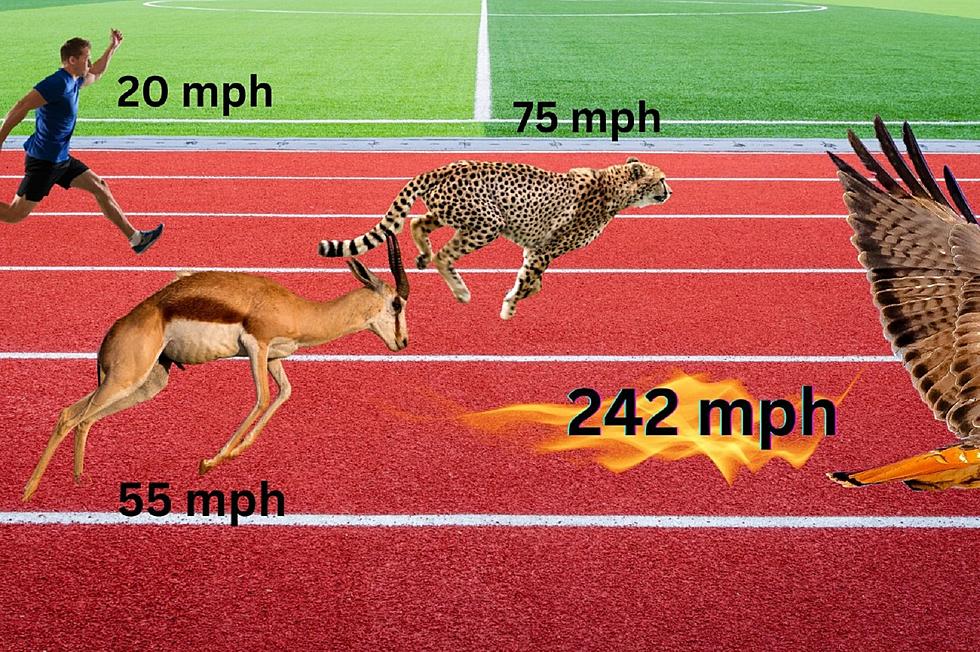
Kentucky Is Home to the Fastest Animal in the World
If you just saw that title, dropped everything, and called someone to tell them we have cheetahs in Kentucky, then you should call them back.
The Cheetah Is the Fastest Land Animal in the World
We do not have cheetahs in Kentucky; talk about throwing a big old industrial-sized monkey wrench into the food chain. You can't even see a cheetah at the Louisville Zoo. (And let's be honest; it makes no sense to have a cheetah in a zoo.)
And really, that parenthetical afterthought shouldn't be so parenthetical. The fastest LAND animal on the planet should never be in ANY kind of confinement. Now you can call your friend back and clarify.
Yes, the cheetah rules the roost in terms of land speed on the Big Blue Marble. But there aren't enough Cheetos in the world to get Chester anywhere near the ACTUAL fastest animal on Earth. For one thing, it doesn't have any wings.
The Fastest Animal in the World Is Right Here in Kentucky
Meet the Peregrine falcon, a raptor that can legitimately claim to be the fastest animal on Earth.
From the Kentucky Department of Fish & Wildlife Resources:
Peregrine falcons are crow-sized raptors that are capable of reaching diving speeds over 200 MPH. After experiencing severe population decline during the mid 1900’s, peregrines bounced back in a big way, thanks mostly to the banning of the pesticide DDT and the widespread release of juvenile birds.
In other words, the Peregrine falcon will leave your Maserati in the dust. It will also leave all other creatures on the planet in the dust, as well. Its poor prey doesn't stand a chance.
Why Kentucky Might Never Been a Home for the Peregrine Falcon
The possibility once existed that we might never have a Peregrine falcon population in the Commonwealth; according to the KDFWR, they were nowhere to be found east of the Mississippi River by the 1970s. But that development was short-lived.
Starting in the 1970’s, cooperative efforts by both public and private organizations nationwide contributed to one of the most successful species recoveries in history. The recovery of the Peregrine Falcon can be credited mostly to the outlawing of DDT in 1972 and widespread hacking (release of juvenile birds). Hacking efforts in Kentucky occurred from 1993-2003, with 82 falcons released in urbanized areas and 32 released in cliff habitats. Kentucky’s nesting population began to reestablish in 1997, when biologists discovered the first pair of Peregrine Falcons nesting in the wild in decades.
How Does Kentucky Accommodate Cliff-Dwelling Peregrine Falcons?
You might be thinking, "Do we have enough high cliffs in Kentucky for these raptors?" Well, whether or not we do, accommodations have been made to keep these once-endangered species thriving. Those accommodations come in the form of nesting boxes placed on tall urban structures:
Where to Find Peregrine Falcons in Kentucky
Thanks to the work done by biologists, ornithologists, and the KDFWR, we've all had a better chance to see Peregrine falcons over the last 50 years. However, they aren't located everywhere in Kentucky; Peregrines are mostly relegated to counties in central, northern, and northeastern Kentucky. In western Kentucky, only Livingston County can lay claim to being a part of the Peregrine falcon's territory.
So here we are, learning something new every day. Come on, you ALWAYS thought the cheetah was the fastest animal on the planet, right? Certainly, you are not alone.
In the meantime, the Peregrine falcon smiles at the humble cheetah and says (squawks), "Hold my beer." Or maybe it's "Hold my beak."
LOOK: Stunning animal photos from around the world
Southern Indiana Photographer Captures Hoosier Birds
Select Wildlife You Could Encounter in Kentucky
More From WKDQ-FM

![Nashville Artist Heads to Sandy Lee Watkins Songwriters Festival [Audio]](http://townsquare.media/site/71/files/2024/07/attachment-GettyImages-1126553953.jpg?w=980&q=75)







